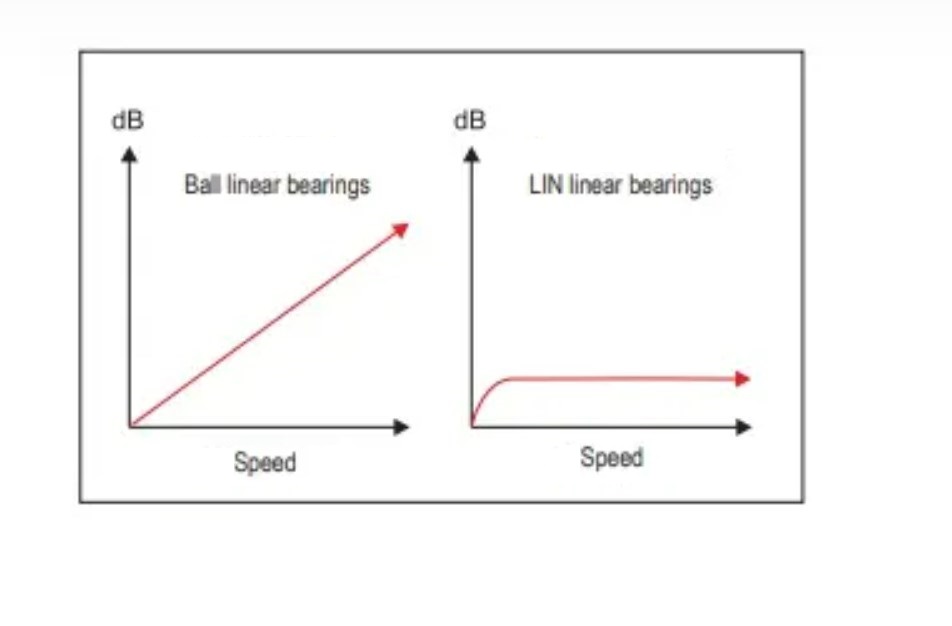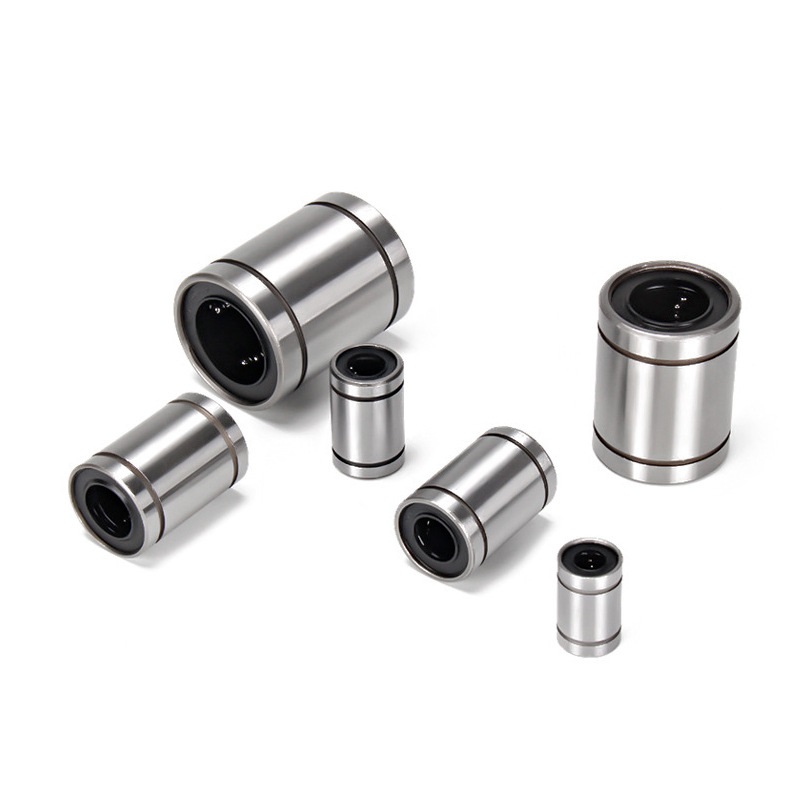Linear bearings are an essential machinery and equipment component requiring smooth and precise linear motion. With a wide range of linear bearing options available on the market, choosing the right one for your application can be overwhelming. This article will discuss ten tips to help you choose the best linear bearing for your needs.
1、Load capacity
Ensure that it is appropriate for the weight and direction of the load it will be supporting.
It refers to the maximum weight that a bearing can support without experiencing premature failure or damage. When selecting a linear bearing, it is important to consider the weight of the moving parts and the load they will be carrying to ensure that the bearing can handle the required load capacity. Additionally, it is important to consider any dynamic loads present in the application, such as shock or vibration.
The load capacity of a linear bearing is typically determined by its size, shape, and materials. More oversized bearings generally have higher load capacities than smaller ones. The form of the bearing can also affect its load capacity. For example, cylindrical or spherical bearings typically handle higher loads than flat ones. If the load capacity of the bearing is exceeded, it can result in premature wear, damage to the bearing, and potential failure of the entire system.
2、Speed
The speed at which the bearing will be moving can impact its performance and longevity, so it's essential to select a bearing that can handle the speed of the application.
Choosing a linear bearing that can handle the speed of the application is crucial to ensure optimal performance because designers have designed linear bearings to operate within a specific range of rates. If the bearing operates at a too high speed, it may experience premature wear or damage, which can result in costly downtime and repairs. On the other hand, if the bearing operates at a speed that is too low, it may not function efficiently and can cause further issues, such as excess friction, which can reduce the lifespan of the bearing.
When selecting a linear bearing based on speed, it is essential to consider the maximum speed at which the bearing will be moving. It includes the speed of the moving parts and any additional factors that can affect the bearing's performance, such as acceleration, deceleration, and shock loads. Therefore, choosing a linear bearing that can handle the speed at which your application will be moving is important to ensure reliable and long-lasting performance.

3、Precision
For applications that require accurate positioning or smooth movement, choosing a bearing with the appropriate level of precision is essential. It is because precise movement is critical in many applications, such as in the manufacturing industry, where accurate positioning of machines is necessary to produce high-quality products. A linear bearing with the appropriate level of precision can ensure smooth and precise movement, resulting in better performance and higher efficiency in the application.
Linear bearings are available in various levels, from standard to high precision. The precision of an approach refers to its ability to maintain a consistent and repeatable position or movement, even under varying loads and operating conditions. Choosing a bearing with the appropriate level of precision for the application can ensure optimal performance and accuracy. For example, CNC machines or robotics applications may require high-precision approaches to achieve precise movements and positioning.
When selecting a linear bearing based on precision, it's essential to consider factors such as the desired accuracy, repeatability, and smoothness of movement. It's also necessary to consider the operating conditions, such as the temperature, humidity, exposure to contaminants, load capacity, and speed, as these factors can affect the precision of the bearing.
4、Noise
Noise is significant when selecting a linear bearing, particularly for essential applications of quiet operation. Linear bearings' noise production during the process can be problematic for applications requiring low noise levels, such as medical or audio equipment.
If noise is a concern, choosing a linear bearing with low noise levels is important. Bearings that use recirculating balls or rollers may produce more noise than plain bearings, so it's important to consider the noise levels of different bearing types when selecting.
Bearings with lower noise levels typically use design features such as precision-ground balls or rollers, low-friction materials, and vibration damping to reduce noise levels during operation. Choosing a bearing with these features can help minimize noise levels and ensure quiet operation. Also, noise can indicate wear and tear on the bearing, so choosing a low-noise bearing can help increase its lifespan and reduce maintenance requirements.
It's important to note that the application's operating conditions can also affect the noise levels of a linear bearing. Factors such as load, speed, and temperature can impact the noise levels of the bearing. For example, higher speeds or loads may produce more noise, while cooler operating temperatures may reduce noise levels.
When selecting a linear bearing based on noise, it's essential to consider the noise levels of the bearing and the operating conditions of the application. Choosing a bearing with low noise levels can help ensure optimal performance and reduce the risk of noise-related issues. It's important to choose a linear bearing with low noise levels and consider the application's operating conditions to ensure optimal performance.
5、Type of Motion
Manufacturers design linear bearings for linear motion applications, where the motion follows a straight line or path, and commonly use this type of motion in applications such as conveyor systems, linear actuators, and CNC machines. Linear bearings come in various styles, including ball, roller, and plain. Every kind of linear bearing has unique advantages and disadvantages, and the type of motion required for your application will dictate which type of linear bearing best suits your needs.

6、Material
For example, suppose your application requires the bearing to operate in a high-temperature environment. In that case, choose an approach of materials such as high-temperature steel or ceramics, which can withstand these conditions without losing their structural integrity or lubrication properties.
Suppose your application involves exposure to moisture or chemicals. In that case, choose a bearing made of materials such as stainless steel or plastic, which are resistant to corrosion and chemical damage. In addition to the material of the bearing itself, it's also important to consider the materials of the surrounding components, such as the guide rail or housing, to ensure compatibility and prevent any corrosion or wear issues.
Selecting the appropriate material for your linear bearing can significantly impact its performance and lifespan. By considering the environmental factors and conditions your bearing will be exposed to and choosing a bearing made of appropriate materials, you can ensure optimal performance and longevity of your equipment.
7、Maintenance
The maintenance requirements of a linear bearing can vary, with some requiring frequent maintenance and others being designed to be maintenance-free. These differences can impact the overall cost and reliability of the application. Linear bearings that require regular maintenance may need to be regularly lubricated, cleaned, or inspected to ensure optimal performance and longevity. It can be time-consuming and may require specialized tools or expertise. On the other hand, maintenance-free bearings typically have longer service lives and require less frequent maintenance, reducing the overall cost and hassle of maintaining the application.
When selecting a linear bearing, it's essential to consider the maintenance requirements and factor them into the overall cost and reliability of the application. Bearings with higher load capacities or precision levels may require more frequent maintenance to ensure optimal performance. In comparison, bearings with lower load capacities or precision levels may be able to operate for more extended periods without supervision.
8、Environmental
Environmental factors are an essential consideration when selecting a linear bearing, as the operating environment can significantly impact the performance and lifespan of the linear bearing. Factors such as temperature, humidity, and exposure to contaminants can all affect the performance of the bearing.
Temperature is a critical environmental factor to consider when selecting a linear bearing. High temperatures can cause lubricants to break down, increasing friction and wear on the bearing. In contrast, low temperatures can cause oils to thicken, reducing the effectiveness of the lubrication and potentially leading to damage or failure of the bearing. It's important to choose a linear bearing that can withstand the operating temperature range of the application to ensure optimal performance and longevity.
Humidity is another important environmental factor to consider when selecting a linear bearing. High humidity can cause corrosion and rust on the bearing, leading to reduced performance and potentially even failure. Bearings exposed to high humidity levels should be made from corrosion-resistant materials or coated with protective materials to prevent rust.
Contaminant exposure is also an important environmental factor when selecting a linear bearing. Contaminants such as dust, dirt, and debris can enter the bearing and cause damage or failure. Bearings used in dirty or dusty environments should be sealed or shielded to prevent contaminants from entering the bearing.
Other environmental factors to consider when selecting a linear bearing include exposure to chemicals, radiation, or electromagnetic interference. It's important to choose a bearing that can withstand the specific environmental conditions of the application to ensure optimal performance and longevity.

9、Installation
The ease of installation can impact the time and cost of implementing the bearing into the application. Some linear bearings require specialized tools or techniques to install. It can increase the complexity and cost of installation and the potential for errors during installation. Other easily installed bearings with basic tools, such as screwdrivers or wrenches, are available as an alternative. Manufacturers often design these bearings with features that simplify installation, such as pre-drilled holes or mounting brackets.
In addition to ease of installation, it's also important to consider the alignment of the linear bearing during installation. Proper alignment is essential for optimal performance and longevity of the linear bearing. Misaligned bearings can increase friction, wear, and even failure over time.To ensure proper alignment during installation, it may be necessary to use specialized tools or techniques, such as laser alignment or precision leveling. Following the manufacturer's recommended installation procedures and ensuring the bearing is installed correctly to ensure optimal performance and longevity is important.
10、Cost
Cost is a critical consideration when selecting a linear bearing, as it can significantly impact the overall cost of the application. However, it's important to balance cost with performance and reliability.
While choosing a lower-cost bearing to save money may be tempting, it's important to consider the long-term costs associated with the bearing. Lower-cost bearings may have shorter lifespans or require more frequent maintenance, leading to higher prices over time.
On the other hand, choosing a higher-cost bearing can provide longer lifespans and reduced maintenance requirements, leading to lower long-term costs. It's important to evaluate the total cost of ownership of the bearing, which includes not only the initial cost but also factors such as maintenance, repair, and replacement costs over the expected lifespan of the bearing.
In addition, it's important to consider the overall performance and reliability of the bearing when evaluating its cost. A higher-cost bearing may offer superior performance, precision, and noise levels, leading to improved overall efficiency and productivity of the application.
11、Compatible
When selecting a linear bearing, it's crucial to ensure it is compatible with other components in your application, such as the guide rail. Incompatible elements can result in poor performance, increased wear and tear, and potentially catastrophic failures.
One important consideration when evaluating compatibility is the size and shape of the bearing and guide rail. Ensure that the bearing is compatible with the dimensions of the guide rail, including its length, width, and height. Additionally, check for any required features or mounting configurations for compatibility, such as flanges or mounting holes.
It's also important to consider any special environmental or operating conditions affecting compatibility. For example, if your application operates in a corrosive or high-temperature environment, ensure that the bearing and guide rail are compatible with these conditions and can withstand the requirements.
Overall, ensuring compatibility between your application's linear bearing and other components is essential for achieving optimal performance, reliability, and safety. Take the time to carefully evaluate the compatibility requirements of your application and select a bearing that meets all requirements for compatibility.
12、Reliable bearing
Choosing a reliable bearing can help you avoid costly downtime, maintenance, and repairs and ensure your application operates smoothly and efficiently.
To assess the reliability of a linear bearing, consider factors such as its material quality, design, manufacturing process, and any industry certifications or standards it may meet. Look for bearings made from high-quality materials that are resistant to wear, corrosion, and other forms of damage. Additionally, consider the design and manufacturing process of the bearing to ensure that it meets rigorous quality standards and produces with consistent and reliable techniques.
Another way to assess the reliability of a linear bearing is to look for industry certifications or standards that the bearing may meet. For example, many bearings are designed to meet ISO standards for quality, performance, and reliability. By selecting a bearing that meets these standards, you can be confident that it has been rigorously tested and evaluated for reliability and performance.
Finally, it can be helpful to research the experiences of other users who have employed similar linear bearings in similar applications. Reading reviews, consulting with industry experts, and seeking recommendations from other users can provide valuable insight into the reliability and performance of different linear bearing options. Take the time to carefully evaluate the reliability of different bearing options, and select a bearing that has a proven track record of performance and meets rigorous industry standards for quality and reliability.
13、Manufacturer's reputation
The manufacturer's reputation is an essential factor to consider when selecting a linear bearing. A reputable manufacturer will have a proven record of producing high-quality and reliable bearings, ensuring long-term performance and durability. Look for manufacturers with a good reputation in the industry and read reviews from other customers to get an idea of their experience with the manufacturer and their products. Additionally, a reputable manufacturer is more likely to have a strong customer support team, which can be helpful if you encounter any issues with your bearing. Choosing a reputable manufacturer can give you peace of mind and help you avoid potential headaches.

In Conclusion
When selecting a linear bearing for your application, it is essential to start by clearly defining the requirements of the application. Consider factors such as load capacity, speed, precision, noise, and type of motion, and analyze them in the context of the trade-offs discussed in the ten tips for choosing a linear bearing. From there, identify two or three suitable configurations for further exploration, and consider all details such as preload, cleanliness, seals, material requirements, lubrication, and duty cycle.
It's important to determine your priorities and make trade-offs accordingly. Keep in mind that a customization is always an option for sufficient volumes. Additionally, when selecting a bearing, it's crucial to consider the manufacturer's reputation and the quality of its design and manufacturing processes to ensure consistent and reliable performance. By following these guidelines, you can make an informed decision and choose the best linear bearing for your application.





